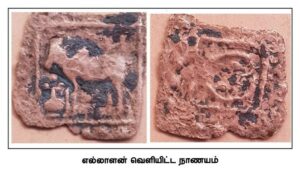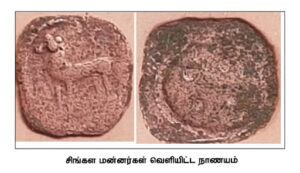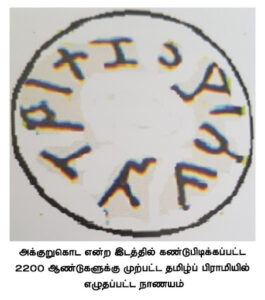by Prof. Paramu Pushparatnam, Ezhuna Online, September 6, 2023
[translated from the original Tamil by Google Translate with improvements by S-J]

Coin minted by King Ellalan
As far as Sri Lanka is concerned, the ancient history of the Tamils is still shrouded in Mahavamsa darkness, but recent archaeological studies in various parts of Sri Lanka have revealed the biographical information of the Tamil people who originally lived in Sri Lanka. In this way, the series, ‘Recent Archaeological Studies of Sri Lanka’, is based on the archaeological evidence found in the series of excavations taking place in Sri Lanka, especially in the North-Eastern areas, the civilization of Sri Lankan Tamil people during the Paleolithic period, their cultural and cultural aspects, economic and social conditions, foreign relations, relations, religious activities, etc. The purpose of the series is to bring out the issues objectively.
Long-traditional historical beliefs about the indigenous people of Sri Lanka and their culture are being re-examined by recent archaeological research. One of Sri Lanka’s senior archeologists, Professor Senakabandaranayake, who claims that civilization had appeared in Sri Lanka before Vijayan’s arrival, says that the history and culture of the Sri Lankan people should be explored starting with the cultures before Vijayan’s arrival. The North Indian migration under the leadership of Vijayan is said to have taken place Before the Current Era (BC). Reliable archeological evidence has confirmed that the Neolithic people lived as nomads in Sri Lanka before the 6th century BC and later the Mesolithic people who were responsible for the creation of civilization.
In this case, scholars such as Prof. Chattamangala Karunaratna (1962), Fernando (1969), and Arya Abhayasinghe (1975), who studied the origin and development of writing, which is important evidence to identify the ancient languages that were in circulation in Sri Lanka, wrote that before the introduction of the Brahmi writing form from North India with Buddhism in Sri Lanka, the Tamil language – Tamil Brahmi – was introduced. Pottery inscriptions from Paleolithic centers confirm that the Tamil Brahmi script came into use in Sri Lanka as early as 2,500 years ago. This evidence underscores the need to reexamine not only the indigenous history of the Sri Lankan Tamils, but also the traditional beliefs about royal succession that may have arisen among them. An important proof of the presence of the script are the ancient Tamil coins that were in circulation in Sri Lanka.
Coins do not provide detailed historical information like inscriptions or literature do. However, coins issued by a reigning dynasty or a king are considered reliable evidence because they are contemporaneous. For this, in studies of ancient India, coins have brought to light some royal dynasties, kings and petty kings that were not mentioned in the inscriptions. The ancient Tamil coins in circulation in Sri Lanka do not seem to have been explored so far for this purpose.
Coin issued by Ellalan?
The coins used in Sri Lanka during the early historical period are similar to the square coin tradition introduced by Moovendar (three kings) of Sangam in Tamil Nadu. The tradition of issuing coins in square form is said to be a unique feature of the Sangam period. Thus, it can be said that the square-shaped coins used in Sri Lanka were issued following the tradition of Tamil Nadu. On the obverse side of this coin [we are discussing here] used in Sri Lanka, there is a figure of a bull standing inside a square box in Koturu, and below its head is an altar-like figure. On the reverse side of the coin there is a circle within a square line, and within that circle are three dots in some, and in others four dots. Many scholars who have studied these coins say that they came to Sri Lanka due to the political and commercial relationship with Tamil Nadu as the design of the coin is similar to the coin design issued by the Sangam period Moovendars. An important reason for saying so is the belief that state formation did not appear among Sri Lankan Tamils before the emergence of the Jaffna government.
However, it is important to note that on the reverse side of the coins issued by Moovendar of the Sangam era in Tamil Nadu, fish for Pandiyas, tigers for Cholas, arrows and bows for Cheras, and river symbols for small land states such as Athiyaman are engraved as state emblems. These symbols are not found on the reverse side of the square coins in use in Sri Lanka. On the reverse side of the coin [pictured above] there is a circle within a square line, and within that circle four, and in some coins, three dots. There is much evidence that the coins issued in Tamil Nadu from the Sangam period were in use in Sri Lanka at the same time. But none of the above coins used in Sri Lanka have been found in Tamil Nadu. If these coins had been issued by the Sangam kings, they should have been found in greater numbers in Tamil Nadu than in Sri Lanka. The Tamil kings who ruled in Anuradhapura used the bull image and the Sinhalese king used the lion image as their clan symbol or royal symbol. As both kings used similar symbols on the reverse of the coins, these may denote the kingdom or country of Anuradhapura.

Coin minted by Sinhalese king in Anuradhapura
The tradition of the Sinhalese kings considering the lion as their clan heritage and royal symbol is one that is linked to the story of Vijayan’s arrival. Later Sinhalese kings also used this symbol on their coins. But there is no evidence of the bull being used as a royal or sacred symbol in the coins issued by the Sinhalese. Rather, the monument has been used as an art form in Buddhist Sinhalese culture. An example of this is that the bull is carved as a symbol along with symbols of flowers, birds, animals etc. in the Chandravattakal found in the entrance area of Buddhist temples. But the tradition of considering the bull as a sacred symbol in Tamil culture has been going on for a long time. For example, bull (nandi) is used as a sacred symbol and royal emblem in the coins issued during the Jaffna government period. In this case, the coins issued by the Tamil kings who ruled in the Anuradhapura kingdom have the image of a bull engraved on them, indicating that Ammarapu [legacy] had been used by the Tamil kings who ruled in Sri Lanka before the Jaffna coinage.

Coin written in Tamil Brahmi dating back 2200 years found at Akkurugoda in South Lanka
During the first 200 years of the Anuradhapura dynasty, the ten Tamil kings ruled for more than eighty years. Among them, Pali literature says that King Ellaln ruled for 44 years (205-161 BC) with justice. He was the first king to rule for a long time in Sri Lanka. Yet the Pali literature, which emphasizes Theravada Buddhism, primarily tells the history of the kings who served their religion. For example, the Mahavamvam tells the history of King Duttagamini who ruled for only 26 years in 821 poems (செய்யூழ்) and the history of King Ellalan who ruled for 44 years in just 21 poems (செய்யூழ்). Thus the history of Ellalan and his historical works could not be known much from the Pali literature. However, it can be said that the reason for his long rule is the support of the people due to the work he did for them. This is the reason why Duttagamini, who conquered Ellalan, erected a mausoleum at the place of Ellalan’s death and issued an order that people should worship that mausoleum.
Recently, some coins written in Tamil Brahmi dating back 2200 years have been found at Akkurugoda in South Lanka. One of them bears the inscription of Sadanagarasan who ruled at Dissapuram. From this it is revealed that there was a rule of Tamil princes in South Lanka and they issued coins. The Mahavamsam also mentions the rule of 32 Tamil minor kings in Southern Lanka on behalf of Ellalan’s rule. There are many sources in the Mahavamsa about some who were minor kings in South Sri Lanka who later took over as kings of Anuradhapura. Here, the period when King Ellalan ruled in Anuradhapuram and the period when bull-shaped coins were in use are found to be almost the same period. Thus, it is appropriate to consider this coin [we are discussing in this article] as the coin issued by King Ellalan when he was the king of Anuradhapura.
About the Author

Paramu Pushparatnam
Paramu Pushparatnam, a senior professor at the University of Jaffna, received his Bachelor’s and Master’s degrees from the University of Jaffna and his Master’s degree in Finance from Thanjavur University.
Out of the fifteen books written by him, four books won the Sri Lankan Government Sahitya Mandal Prize and three books won the Provincial Sahitya Mandal Prize. He has written more than 82 national and international research papers and participated in 55 international and national seminars.
For other articles, links are available on https://ezhunaonline.com/tamil-coin-of-ellalan/
- Archaeological Excavations at Kattukkarai, Illustrating the Indigenous History and Culture of Sri Lankan Tamils – Part 1
- Kattukarai Archeological Excavations Revealing the Indigenous History and Culture of the Sri Lankan Tamils – Part 2
- Archaeological Excavations at Kattukkarai, Illustrating the Native History and Culture of Sri Lankan Tamils – Part 3
- Archaeological Excavations at Kattukkarai, Illustrating the Indigenous History and Culture of Sri Lankan Tamils – Part 4
- A thousand year old Shiva temple in the Tirumangalai forest of Trincomalee
- Another rare Tamil inscription found in the Vanni plateau
- Discovery of rare Tamil inscription in Trincomalee re-examines previous historical view of origin of Tamil kingdom
- A Saivite Tamil village is disappearing from the history of Amparai district
- A rare Tamil inscription which has come to historical light after many years has been rediscovered in Tambalagam
- The ruins of the Kurundankula temple confirm the existence of a Tamil treasury on the Vanni plateau before the emergence of the Jaffna government.
- The biggest undiscovered tourist destination in Vanni
- Recent Archaeological Surveys of Jaffna Fort – A New Perspective – Part 1
- Recent Archaeological Surveys of Jaffna Fort – A New Perspective – Part 2
- Recent Archaeological Surveys of Jaffna Fort – A New Perspective – Part 3
- Jaffna Fort Excavation revisits the origins of the city of Jaffna
- Rare Coins Commemorating Lord Muruga Issued by Bhubanekabaku who reigned in the Jaffna Kingdom